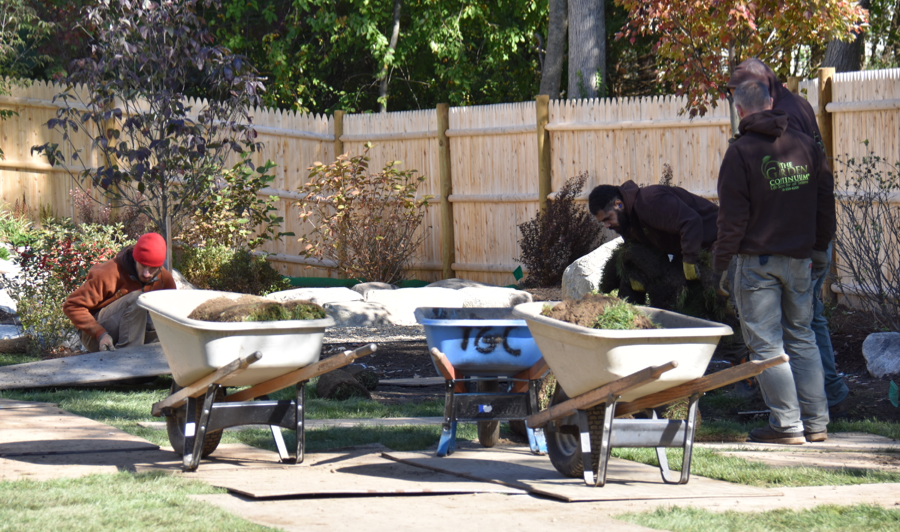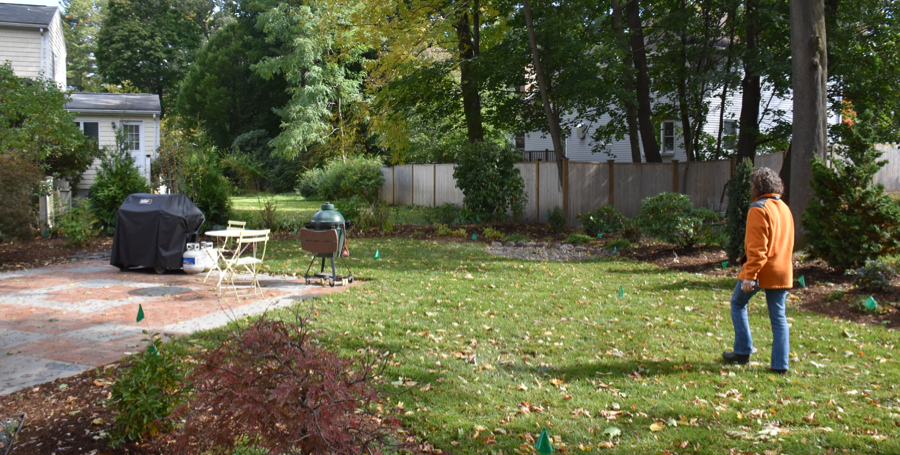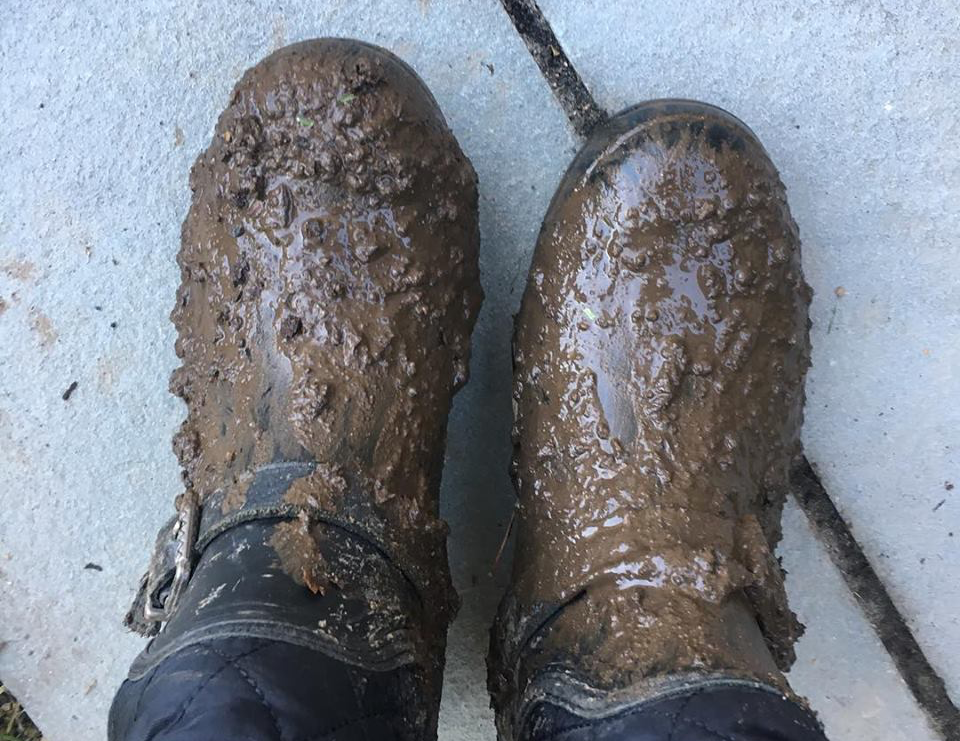The 2018 growing season is coming to a close. Thanksgiving is behind us and the next holiday season is closing in. In Massachusetts, we’ve already had eight inches of snow dumped on us. At my company, as we’re valiantly struggling to keep working through the snow, rain, frost, and mud, I realize the mixed blessing that garden making is for me, my staff and our clients. Full of ups and downs, successes and failures, working in the landscape and with nature is not a task that anyone should take on if they expect a predictable, repeatable work environment. That isn’t a good description of the outside work life...at least not where I live.
In New England - Weather Rules!
Lesson 1: I’m blessed that I get to do this work!
The fundamental blessing of working in the landscape is easy to understand and see whether you are a professional or an amateur, a homeowner or apartment dweller (I’ve been them all). If you are planting plants and creating with nature, you get to be outside! I mean how cool is that? We get to play in the dirt and get paid for it. We get to plant and grow things, climb ladders and shape things, stack rocks, lay pavers, build and create spaces. Every day is like a day in the sandbox building castles! On beautiful days with sun, clear skies, and soft breezes, I have to pinch myself to be sure I’m not dreaming. It’s awesome!
Lesson 2: The weather looks different now.
Looking at the New England weather patterns of today, I realize how much things have changed in our environment from when I started this work back in the 80’s. I mean, we’ve always had freaky snow events that come at odd times. I remember the Halloween storm of 2011 that dumped more than a foot of snow on trees still full of leaves, causing breakage and mayhem in our landscapes. So I’m not so concerned about this mid-November storm. We’ll just keep working through it as we’ve done in the past, taking it in stride like a seasoned pro.
No, the things that concern me are the shifts in the bridge months - February and March as well as October and November. These months seem colder, wetter, and sometimes warmer and drier. They are the gateways to our growing season and set the tone for the entire year. And for me, they are critical to running a successful business. It’s all about the extremes that come at times when they aren’t expected.
Like a crazy warm February followed by a really cold and snowy March. Or a wildly rainy September and October leading into snow in November. The mud this year was amazing! We had so much rain that the ground was saturated beyond capacity. I was going through one set of boots after another as I tested the ground to see if we could work. We finally laid our last sod job using plywood to bridge in and out, so we could avoid ever stepping on the bare ground.

Lesson 3: Every season has information that you can use in the next season.
I think that what we experience in each season and in any one year should be taken with a grain of salt (meaning “don’t panic, the sky is NOT falling – it’s just data”). Remember the knowledge gained, the insight it provides, and refer back to it when we plan for the year to come.
We can be sure that the reasons for what we experience today are somewhat connected and locked into what happened in the past (profound life message disguised as gardening advice). Everything from insect pressure, disease processes, growth rates, flowering levels and more can be linked back to the weather of the previous seasons or years. Plants are wonderful storytellers. What are your plants telling you?
As gardeners, we can weave a story of life with our landscapes by participating with a focused awareness about the weather. Not just what it’s like today, but paying attention to what happened yesterday. If it rained yesterday but it’s sunny today, it still may be far too wet to do some activities in the landscape. We need to give the soil recovery time before we tromp all over it. Patience is a gift we give to Nature, allowing it to take the time it needs to respond to the environment.
Lesson 4: The elements of weather that have an impact on your landscape.
A dry season outside the norm with drought, extreme heat, high humidity - all stress the plants and soil biology. Extreme conditions will tax and even weaken plants as they move into the next season. Our warm February of 2018 set many plants up for failure this year. Most notably were roses. I would call 2018 a dud year for roses while 2017 was a spectacular rose year. All that growth couldn’t be sustained in 2018, and we lost roses to the February warmth followed by the extreme cold of March. I’m not giving up on roses and hope you won’t either. I was diligent this year and made sure that all our roses had a nice compost layer added to their bud union area to keep it covered over winter. We’re also setting up our burlap barriers where salt, sand, wind, and snow loads may damage roses over the winter.
Rain We love rain, right? Overnight is best because we can garden during the day. Of course, rain makes easy work of gardening when it’s light and easy-going and consistent enough to keep even moisture in the soil. But when the rain comes fast and furious and repeatedly, it can cause so much trouble. Ask anyone who’s experienced any kind of flood disaster - big or small - how troubling rain can be.
This year was nutty, and I feel blessed for where we live and how well most of our landscapes, towns, and cities fared through all the rain this fall. I noticed that how roofs drain is critical for protecting both the house and the landscape. Roof drainage needs to be addressed for all homes, new and old.
Twenty-five years ago, I didn't think I gave a single thought to drainage. 15 years ago, I started actively addressing drainage solutions for all of our projects. About 5 years ago, I started shoring up those practices as the rainfall really felt like it was shifting. This year, I’m rethinking my methods again and making plans for how we’ll address drainage and storm water management in 2019. We are seeing more rain coming at one time, more massive storms, more extended storms, and more frequent storms. Damage to homes and landscapes is increasing and it demands proper attention to design right from the start, with retrofitted solutions for existing homes and landscapes.
Frost As New Englanders, we know all about frost. We get a frost that goes several feet down and holds tight until later each year. Seems I remember starting to garden in March back in my youth (haha - that was a while ago now). But seriously, we always used to say that we’d be outside before the first day of spring. Little by little that’s shifted. Now, I’m thrilled if we can get out and start working on April 1st. For the past couple of years, it’s been mid-April. It makes me think that the term “global warming” just doesn’t apply. I’m joking, of course, I know that climate change is real (RAIN reality), but it just feels colder, not warmer, in the spring and that makes me a little sad. I love getting out there in the spring season. Waiting is so hard. I do hope we can make a March start in 2019.

TWEETABLE TIP
We get to play in the dirt and get paid for it. Every day is like a day in the sandbox building castles!
VIA @GardenContinuum

Snow These early snows are nothing new. For as long as I can remember, rogue snow events happen. I remember the April Fool’s Day snow in 1997 that dumped like 3 feet in Massachusetts. We had already been working for about 10 days doing spring clean ups, then wham! We were shut down for a week. The nice thing about spring snow is that it melts fast and we can usually get right back to work. It’s a little different with late fall snow. The November 15th snowstorm covered us with eight inches, and as I write this blog, it’s still lingering. I’m praying for enough thaw to allow me to finish all the garden cleanups and closedowns still on the list.
When I look back on 2018, I can smile and say we did good work. We managed to deal with the late spring start, the heat of summer and even the rains of the fall. We pay a lot of attention to the weather and were able to predict that fast close to the year and got all of our bulbs installed before the snow. We saved enough work that can be done in the winter season that will help me keep the team on the payroll into December. Of course, we haven’t gotten all the leaves up yet. Have you? We know that there will be more to do in the springtime now that the fall hasn’t cooperated with our plans.
The greatest lesson that I can share with you is to practice patience and resilience and let Nature be your teacher. Nature bounces back eventually. And in the meantime, she adapts. Nothing is fast, nothing is permanent, nothing is guaranteed. This may feel like a doom-and-gloom statement, but I see it as liberating. We are free to try, to test, to respond in love and kindness to Mother Nature as she tosses curve-balls our way. We become nimble and resourceful. And, in the end, better gardeners and landscape stewards.
So, with that, I wrap up the 2018 TGC Landscape Design and Garden Blog posts for the year. Time to take a rest and restore the well. I wish everyone a blessed winter season. I’ll be back to garden blogging in the spring.
Till then enjoy the beauty of winter!










Leave a comment